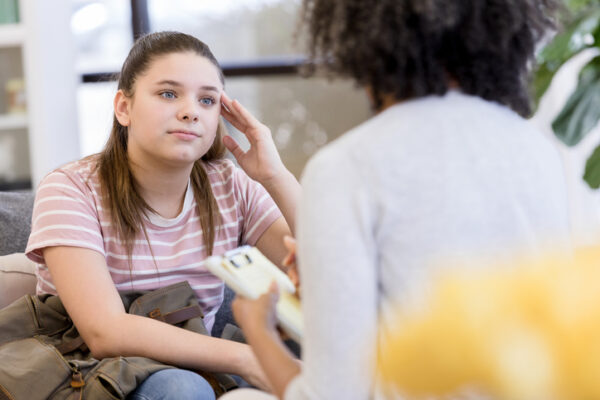
Physicians who work with children and teens have seen it before: The “summer slump.” When school lets out for summer break, students no longer follow routines, complete tasks or participate in groups during the summer break, and feelings of isolation and decreased social interaction can follow.
To fill time, there’s often more online use, particularly social media, exposure that’s not always healthy and can never replace face-to-face interaction. Mix it, and you’ve got a perfect storm for learning loss, boredom, unproductivity, and loneliness. All of this can heighten a child’s depression, anxiety, and attention deficit hyperactivity disorder (ADHD).
The data supporting this indicates that its impact is far-reaching and that physicians can help parents and caregivers combat the “summer slump.”

As Healthcare and Biopharma Companies Embrace AI, Insurance Underwriters See Risks and Opportunities
In an interview, Munich Re Specialty Senior Vice President Jim Craig talked about the risk that accompanies innovation and the important role that insurers play.
According to a study by the American Education Research Association, summer break causes 52% of students to forget an average of 39% of the gains they made during the school year. A 2023 study by Mental Health America showed while 2 million youths experienced depression, roughly 60% went untreated. The U.S. Department of Education also notes: “Students are six times more likely to receive mental health services when they are delivered at school.” There is a mental health crisis, and schools are the one place many young people get help. But when classes let out, and services aren’t available, mental health gets neglected.
Parents and behavioral activation
It’s important to keep in mind that parents, with physician support, can beat the summer slump, particularly with planning and resources. For instance, there’s behavioral activation, which involves scheduling activities that encourage children to reconnect with environmental positive reinforcement and decrease avoidant behaviors and negative emotions.
There are many activities parents can leverage, like consistent exercising, going out to dinner, and for younger children, things like ensuring personal hygiene through basics like showering regularly.

NEMT Partner Guide: Why Payers and Providers Should Choose MediDrive’s TMS
Alan Murray on improving access for medical transportation.
Caregivers should begin by having open conversations with children about their mental health. They should also create a safe and non-judgmental environment and build trust. From there, caregivers can work with children to create a plan that shows that they see them, are invested in them, and will do what’s necessary to help their children achieve long-term success.
What’s more, with parents often working, supervision can be tough to arrange. Making matters worse, when family members are running in different directions, food insecurity can occur. This happens when there’s no consistent access to nutritious food, which can also impact physical and mental health.
To keep tabs on children, the National Institute of Mental Health has identified signs that indicate a decline in mental health. For children, signs range from frequent tantrums and sleep issues to imagined health problems and a lack of interest in continuing or making new friendships, among others. For teens, signs include low energy and fear of gaining weight to self-harm behaviors and use of alcohol and drugs.
Readily available resources
When planning or encouraging activities for behavioral activation, parents should explore available resources. These includes:
- Accessible summer programs: Some towns and cities have a lot to offer children in the summer. Check out community centers, libraries, area gyms, and nonprofits to take advantage of what are often low-cost or even free programs.
- Online education: Name the subject and there’s an online educational program for it. The options are virtually limitless if a child wants fundamentals like math or languages. Then again, maybe something other than a traditional course will grab their attention, helping them to learn while having fun.
- Social network: We all need friends and the opportunities for interaction that come along with them. Facilitate activities with friends and consider coordinating activities with other parents.
Still, perhaps the most important resource of all is mental health support, which is often led by their primary care physician.
Tools and tech for teens
Technology can lend a hand. A Gallup survey has shown teens spend nearly 5 hours per day on social media. Web-based behavioral health apps offer teens a safe place to talk about issues with both peers and qualified professionals. The support is often 24×7, and the platforms can help identify those who may be in danger and alert trained professionals to handle the situation.
These apps reach students where they are, online, and teach coping skills for critical but basic things like managing anxiety. Sometimes teens can handle issues with a self-service approach that doesn’t require in-person therapy or medications. In the summer, these apps can keep teens from slipping through the cracks when they may have easily treatable issues.
Like any other holistic advice to give patients, keep the three Rs of summer mental health in mind: rest, recreation, and routine. Sleep plays a critical role in learning and our mental health. Kids should experience healthy movement, particularly by being outside and engaging in exercise. Ultimately, caregivers must ensure children have set routines, however, physicians can help outline the framework and explain expectations for healthy children (and families).
Photo: SDI Productions, Getty Images
AJ Harris is a Senior Care Specialist of Coaching at Brightline. AJ has extensive experience in working with children and adolescents through a variety of care modalities. AJ holds a Masters Degree in Psychology with a Clinical focus on Child and Adolescent Development and Cognition. At Brightline, AJ delivers 1:1 care to children and families while also building programs and content to be utilized by providers and members alike.
Annie Certo is the Sr. Manager of Coaching at Brightline. She holds a Masters Degree in Counseling Psychology with an extensive background in community mental health in addition to the Foster Care, Juvenile Justice and School systems.Prior to joining Brightline as a Behavioral Health Coach in June 2021, she worked as a health coach for a medically supervised wellness program where she had the opportunity to coach hundreds of individuals utilizing motivational interviewing and CBT interventions for behavior change around health, wellness, weight loss and chronic disease prevention via individual and live group coaching modalities. She also has clinical training and spent years working in community mental health, the school system (elementary and middle), and as a program supervisor and case manager for foster care youth and youth within the juvenile justice system.
This post appears through the MedCity Influencers program. Anyone can publish their perspective on business and innovation in healthcare on MedCity News through MedCity Influencers. Click here to find out how.







